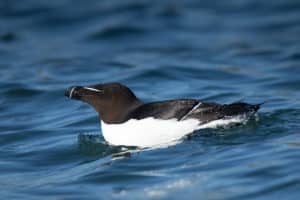Species Spotlight: Razorbill
Jan 23, 2017 | by Kevin Loughlin

Razorbill
This past August, I was fortunate enough to visit Machias Seal Island. While most come to observe the Atlantic Puffins, this island holds far more than just one bird. It’s also home to Arctic Terns, Common Terns, the occasional Northern Harrier that finds it’s way from the mainland to hunt, and the feature of this article. Razorbills!
The Razorbill, or Razor-billed Auk, is the largest surviving member of the Auk family. The Great Auk, now extinct unfortunately, relinquished that title in 1844 after being hunted to extinction. Other notables in the Auk family include the Atlantic Puffin, Common Murre, and the Black Guillemot. Not surprisingly, at least during breeding season and during my visit, all could be seen in close proximity to each other.
Razorbills start to breed at 3-5 years of age, and live an average of 13 years. They are monogamous, sharing one life partner, and they only lay one egg per breeding cycle. One of the greatest parts of the trip to the island for me was observing their courtship rituals. These birds share intimate poses, and “talk” to each other. It’s absolutely fascinating to watch them interact! It was by chance when circling the island in our tour boat, that I was able to capture some of these rituals as shown in the photo below.
While seeing these courtship rituals on land was amazing, most of the Razorbills that I saw were at sea and their antics there were just as interesting to me. They’re quite social, and not just with other Razorbills. I watched them interact equally with Atlantic Puffins and Common Murres. It could just be me wanting to impart human qualities onto these birds, but it seems they have a very strong sense of community during the breeding cycle. They spent about half of their time swimming around and interacting with other birds, and the other half diving for food. Razorbills spend about 44% of their entire life cycle just diving for food. Their ability to dive is astounding, spending much of their time at an average depth of 82 feet! Even more impressive, they have to ability to dive as far down as 390 feet!
Observing these birds was an unforgettable experience for me, and I’ll return to that island for years to come. If you’d like the chance to get up close and personal with them, head to Maine in late spring or early summer. Wildside’s own Greg Miller leads a phenomenal trip in early June as one of his Big Year Series, and a trip to Machias Seal Island is on that schedule! I can’t think of a better way to get to experience everything the island has to offer, as well as so many other birding opportunities!
































